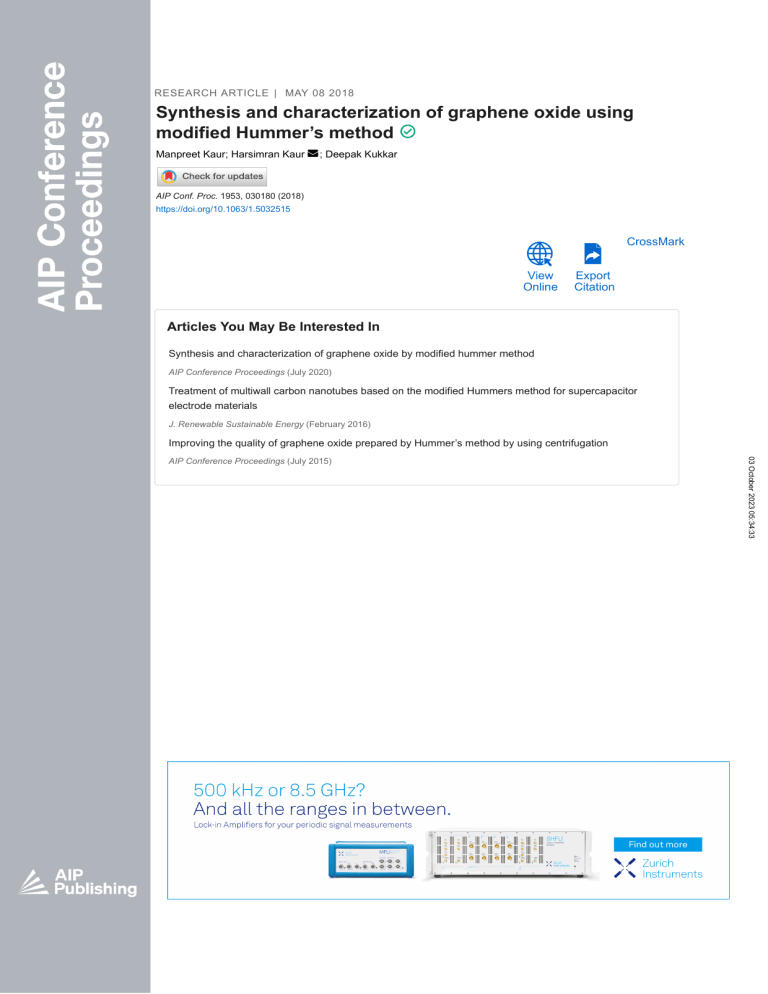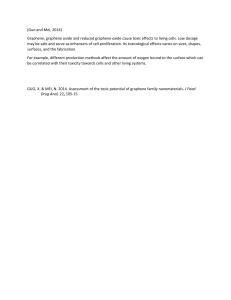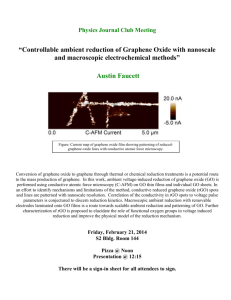
RESEARCH ARTICLE | MAY 08 2018 Synthesis and characterization of graphene oxide using modified Hummer’s method Manpreet Kaur; Harsimran Kaur ; Deepak Kukkar AIP Conf. Proc. 1953, 030180 (2018) https://doi.org/10.1063/1.5032515 View Online CrossMark Export Citation Articles You May Be Interested In Synthesis and characterization of graphene oxide by modified hummer method AIP Conference Proceedings (July 2020) Treatment of multiwall carbon nanotubes based on the modified Hummers method for supercapacitor electrode materials J. Renewable Sustainable Energy (February 2016) Improving the quality of graphene oxide prepared by Hummer’s method by using centrifugation 03 October 2023 05:34:33 AIP Conference Proceedings (July 2015) Synthesis and Characterization of Graphene Oxide Using Modified Hummer’s Method Manpreet Kaur1, Harsimran Kaur1, a) and Deepak Kukkar2, b) 1 Department of Biotechnology, Sri Guru Granth Sahib World University, Fatehgarh Sahib, 140406, Punjab, India 2 Department of Nanotechnology, Sri Guru Granth Sahib World University, Fatehgarh Sahib, 140406, Punjab, India Correspondence: a)microsimbac@gmail.com, b) dr.deepakkukkar@gmail.com INTRODUCTION Carbon based nanomaterials like graphene, carbon nanotubes and activated carbon have unique pore structure, adsorptive capacity, electronic properties and acidity. This has generated tremendous interest in these nano materials for applications in other fields such as physics, chemistry, biology and medicine [1]. Among various carbon nanomaterials, graphene has emerged as a potential candidate for sensing and photoelectronic applications [2]. It is a 2-D honeycomb structure consisting of single atom thick layer of sp2-bonded carbon atoms arranged in a hexagonal lattice. Owing to extraordinary properties such as electrocatalytic ability, physical and chemical properties, GO has found its uses as functional films, electronic devices and other energy storage devices [3]. It also possesses other properties such as high mechanical strength, good electrical conductivity, thermal and chemical stability [4]. A single sheet of graphene is a zero band-gap semiconductor as the valence and conduction bands of graphene consists of bonding (p) and anti-bonding [p-(p*)] [5]. The oxide form of graphene called graphene oxide (GO) shows facile suspension characteristics in water and other polar media owing to high density of oxygen functional groups like hydroxyl, epoxyl group on its basal plane and carboxyl group on its edges [6]. A number of methods have been reported for synthesis of GO such as chemical vapour deposition, mechanical exfoliation and annealing under high vacuum conditions. These methods are not widely employed in lieu of large number of limitations such as toxicity, high temperature annealing, laborious work, costly instruments, time consuming, and use of expensive chemicals [7]. Therefore, chemical methods considered as the most promising routes in terms of simple, less expensive and effective method for the large-scale production of GO containing huge number of oxygen functional groups in sheet structure [8]. Moreover, it possesses high water solubility, ease of functionalization, simple processing which makes it a most popular precursor of graphene. It has large theoretical surface area of about 2630 m2g-1 and low manufacturing cost [9]. All these attributes make it a promising candidate for carrying out practical applications by functionalizing the 2nd International Conference on Condensed Matter and Applied Physics (ICC 2017) AIP Conf. Proc. 1953, 030180-1–030180-4; https://doi.org/10.1063/1.5032515 Published by AIP Publishing. 978-0-7354-1648-2/$30.00 030180-1 03 October 2023 05:34:33 Abstract. In the present study, a simple approach has been followed for the synthesis of graphene oxide (GO) using modified Hummers method in which graphite powder was oxidized in the presence of concentrated H2SO4 and KMnO4. The amount of NaNO3 and KMnO4 was varied to produce sheet like structure. The varied concentrations of NaNO3 and KMnO4 resulted in yielding large amount of the product. Structural, morphological and physicochemical features of the product were studied using UV-Visible spectrophotometer, Fourier Transform infrared spectroscopy (FTIR), and crystal structure was determined using X-ray powder diffraction (XRD). UV-Vis spectra of GO was observed at a maximum absorption of 230 nm due to (π-π*) transition of atomic carbon-carbon bonds. FTIR spectra revealed the presence of oxygen containing functional groups which ensures the complete exfoliation of graphite into graphene oxide X-ray powder diffraction pattern of the product showed the diffraction peak at (2θ = 26.7°) with an interlayer spacing of 0.334 nm. All the above characterizations successfully confirmed the formation of GO. surface of graphene oxide in many different ways. In the present work, GO has been synthesized using modified Hummers method, which is an easy, less time consuming and low cost method. Moreover, using this method more hydrophilic groups are introduced within the carbon material, there is no release of toxic gases and has an increased conductivity. To evaluate the characteristics of the product being formed, UV, FTIR and XRD have been done. MATERIALS AND METHODS All the chemicals, graphite powder, NaNO3, KMnO4, H2SO4, NaOH, H2O2, Conc. HCl were of analytical reagent grade and used as received without any further modification. For the preparation of graphene oxide, modified Hummer’s Method [10] was used, in which graphite powder was used as a starting material. In a typical synthesis, 0.5 g graphite powder was pre-oxidized with 23 ml of concentrated H2SO4 along-with 0.5 g NaNO3. The mixture was then stirred in an ice bath for about 4 h. Approximately 3 g of KMnO4was added slowly into the mixture with an interval of 10minutes and again stirred for 1 hour. Heated the above mixture at 35°C and then added 45 ml of distilled water into it after cooling to room temperature and continued stirring for 1 h. Again the mixture was heated upto 90°C for 2 h with stirring and added 100 ml distilled water into it. About 10 – 15 ml of 30% H2O2was then added to stop the reaction. The mixture was washed with 100 ml of 5% HCl solution and allowed to settle down for about 2 days. In order to remove all the impurities, the mixture was washed with distilled water several times and repeatedly centrifuged at 5000 rpm for 10 minutes. After centrifuging, the mixture was dried at 60 °C to obtain it in the powdered form. RESULTS AND DISCUSSIONS FIGURE 1. Images depicting the formation of GO in the solution and dried form The prepared sample was characterized using UV-Visible spectrophotometer and it is observed that the maximum absorption peak appears at 230nm which is attributed to π-π* transition of the aromatic carbon-carbon (C-C) bonds as shown in Fig. 2(a). In Fig. 2(b), Fourier transform infrared spectroscopy (FTIR) of GO showed a broad peak at 3000-3700 cm-1 and another peak at 1635 cm-1 is due to the stretching and bending vibrations of hydroxyl groups (OH) of water molecules which are absorbed on the surface due to which it possesses the hydrophilic nature. The peaks at 2930 cm-1 and 2850 cm-1 represents the symmetric and anti-symmetric vibrations of CH2, 1630 cm-1 and 740 cm-1 is due to the stretching vibration of C=C and C=O of carboxylic groups present at the egdes of GO. Further, the peaks at 1385 cm-1 and 1110 cm-1 corresponds to the C-O of carboxylic acid and C-OH group of alcohol, which ensures that there are present oxygen containing functional groups and graphene has been completely oxidized. The hydrophilic nature of graphene 030180-2 03 October 2023 05:34:33 GO was prepared by using modified Hummer’s method [10], in which graphite powder was treated with concentrated sulphuric acid and oxidized in the presence of an oxidizing agent. This is a less hazardous and an efficient method to prepare graphene oxide. When dispersed in water, a brown aqueous suspension was obtained and the exfoliation in an ultrasonicator results in the formation of individual and transparent sheets. The surface of graphene oxide is negatively charged which creates electrostatic repulsions among them and makes it hydrophilic. Ionization of carboxyl groups which are initially present at the edges of GO, due to which it is electrostatically stabilized, helps in forming colloidal suspension in alcohols, organic solvents and water. After oxidation of graphite into graphene oxide, a brown colored viscous slurry is formed which contains non-oxidized graphitic particles and residues from other oxidizing agents such as KMNO4. In order to remove salts and ions, and to obtain a monolayer graphene oxide sheet, centrifugation was done several times. Absorbance oxide is due to the formation of hydrogen bonds between graphite and water molecules within the polar hydroxyl groups. Wavelength(nm) (a) (b) FIGURE 2. (a) UV-Visible Spectra and (b) FTIR spectra of Graphene oxide 03 October 2023 05:34:33 FIGURE 3. XRD pattern of graphene oxide (GO) X-ray powder diffraction (XRD) analysis of GO has been done in Fig 3. This technique is used for characterizing the general crystalline structure of a material. It tells about that inter-layer spacing between layers and of atoms. The diffraction peak was observed at (2θ = 26.7°). The prominent peak (001) which appears at a lower angle (2θ = 10.23°) has an interlayer spacing distance of 0.334 nm. Hence, it signifies the complete synthesis of GO. Another dominant diffraction peak (002) at (2θ = 26.58°), refers to an increase in inter-layer spacing distance of 0.961nm which indicates that there is intercalation of oxygen functional groups and water molecules into the carbon layer [10]. CONCLUSION It can be summarized from the present study that; by varying the concentrations of graphite powder, NaNO3 and KMnO4, than the standard procedures, we are able to synthesize GO using modified Hummers method. The UVVisible spectra exhibits maximum absorption at 230 nm attributed to π-π* transition. FTIR spectra and XRD pattern confirmed the presence of oxygen containing functional groups within GO. 030180-3 REFERENCES 1. 2. 3. 4. 5. 6. 7. 8. 9. 10. H. Seyed, B. Shabnam and J. Braz, Chem. Soc. 28, 203-207 (2017). S. Eigler and A. Hirsch, Angew Chem Int Ed. 53, 2–21 (2014). P. Ramana, A. Viswadevarayalu, K. Reddy, A. Reddy and S. Reddy,Korean J. Chem. Eng. 33, 456-464 (2015). E. Antolini, Appl. Catal. B-Environ. 52, 123-124, (2012). F. Yeh, J. Cihla, Y. Chang and H. Teng, Mater. Today. 16, 78-84 (2013) H. Yu, B. Zhang, C. Bulin, R. Li and R. Xing, Sci.Rep. 6, 36143-36150 (2016). J. Song, X. Wang and C. Tang, J. Nanomater. 14, 1-6 (2014). R. Xing, Y. Li and H. Yu, Chem Commun. 52, 390–393 (2016). J. Shen, W. Huang and Y. Mingxin, Ceram. Int. 40, 1379–1385(2014). L. Shahriary and A. Athawale, Int. J. Renew. Energy Environ. Eng. 2, 58-63 (2014). 03 October 2023 05:34:33 030180-4



